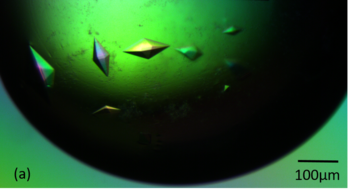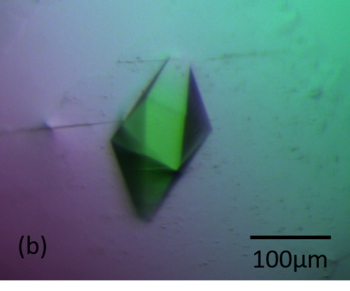Journal:IUCrJ:S2052252521005340
From Proteopedia
(Difference between revisions)

| (6 intermediate revisions not shown.) | |||
| Line 1: | Line 1: | ||
<StructureSection load='' size='450' side='right' scene='88/884898/Cv/1' caption=''> | <StructureSection load='' size='450' side='right' scene='88/884898/Cv/1' caption=''> | ||
| - | ===X-ray crystallography studies of RoAb13 bound to PIYDIN, a part of the CCR5 N terminal domain=== | + | ===X-ray crystallography studies of RoAb13 bound to PIYDIN, a part of the CCR5 N-terminal domain=== |
<big>Lata Govada, Emmanuel Saridakis, Sean C. Kassen, Ahmad Bin-Ramzi, Rhodri Marc Morgan, Benjamin Chain, John R. Helliwell and Naomi E. Chayen</big> <ref>doi: 10.1107/S2052252521005340</ref> | <big>Lata Govada, Emmanuel Saridakis, Sean C. Kassen, Ahmad Bin-Ramzi, Rhodri Marc Morgan, Benjamin Chain, John R. Helliwell and Naomi E. Chayen</big> <ref>doi: 10.1107/S2052252521005340</ref> | ||
<hr/> | <hr/> | ||
| Line 12: | Line 12: | ||
[[Image:Figure_1bbb.png|thumb|350px|left|'''Figure 1b''' Crystals of RoAb13 complexed with the PIYDIN peptide]] | [[Image:Figure_1bbb.png|thumb|350px|left|'''Figure 1b''' Crystals of RoAb13 complexed with the PIYDIN peptide]] | ||
| - | After a long search for co-crystallization conditions involving both the whole N-terminal region of CCR5 and the minimally required binding region to its antibody (the ‘core peptide’), and the analysis and comparison of X-ray crystallographic electron density maps obtained from several crystals, we have finally located the core peptide of the CCR5 receptor bound to RoAb13. It binds at the hypervariable region ‘CDR3’ of the antibody’s light chain, an expected antigen-binding site. In spite of the fact that the best attainable resolution is not particularly high at 3 Å, we have been able to identify the interacting residues between antibody and peptide. | + | After a long search for co-crystallization conditions involving both the whole N-terminal region of CCR5 and the minimally required binding region to its antibody (the ‘core peptide’), and the analysis and comparison of X-ray crystallographic electron density maps obtained from several crystals, we have finally located the core peptide of the CCR5 receptor bound to RoAb13. It binds at the hypervariable region ‘CDR3’ of the antibody’s light chain, an expected antigen-binding site. In spite of the fact that the best attainable resolution is not particularly high at 3 Å, we have been able to identify <scene name='88/884898/Cv/22'>the interacting residues between antibody and peptide PIYDIN</scene> (both cases). |
<scene name='88/884898/Cv/29'>The PIYDIN of the 31 peptide study</scene>; PIYDIN is colored in orange, antibody RoAb13 in cyan/green. We observe that, in the case of the PIYDIN part of the 31 peptide, <scene name='88/884898/Cv/26'>Pro8</scene> of the ligand is near (approximately within 3.5 Å of) tyrosines 98 and 100, and <scene name='88/884898/Cv/27'>Ile12 near Tyr98</scene> of the Light chain. <scene name='88/884898/Cv/28'>Tyr10 of the ligand comes near Asp61 and Arg64</scene> of the Heavy chain. <scene name='88/884898/Cv/30'>Asp11</scene> is only engaged in intra-peptide interactions, with Ile12 and Asn13. | <scene name='88/884898/Cv/29'>The PIYDIN of the 31 peptide study</scene>; PIYDIN is colored in orange, antibody RoAb13 in cyan/green. We observe that, in the case of the PIYDIN part of the 31 peptide, <scene name='88/884898/Cv/26'>Pro8</scene> of the ligand is near (approximately within 3.5 Å of) tyrosines 98 and 100, and <scene name='88/884898/Cv/27'>Ile12 near Tyr98</scene> of the Light chain. <scene name='88/884898/Cv/28'>Tyr10 of the ligand comes near Asp61 and Arg64</scene> of the Heavy chain. <scene name='88/884898/Cv/30'>Asp11</scene> is only engaged in intra-peptide interactions, with Ile12 and Asn13. | ||
| - | <scene name='88/884898/Cv/ | + | In the <scene name='88/884898/Cv/31'>PIYDIN only study</scene>, Ile9 (in hot pink) additionally comes near <scene name='88/884898/Cv/32'>Thr99</scene> (in deep sky blue) of the Light chain. The corresponding distance is ca. 5 Å for the 31 peptide structure (Ile9 is in orange; Thr99 in cyan). PIYDIN is colored in magenta, antibody RoAb13 in cyan/green. |
| - | + | ||
'''The PIYDIN of the 31 peptide study (Figure 2a):''' | '''The PIYDIN of the 31 peptide study (Figure 2a):''' | ||
| Line 40: | Line 39: | ||
Furthermore, the core peptide was found to bind in a way that can accommodate the full length of the CCR5 N-terminus. | Furthermore, the core peptide was found to bind in a way that can accommodate the full length of the CCR5 N-terminus. | ||
The structural insights thus may inform the design of better peptide analogues for use as immunogens in vivo. These analogues may ultimately provide the basis for active immunization vaccines to stimulate an antibody response to native CCR5 which will thwart HIV infection. | The structural insights thus may inform the design of better peptide analogues for use as immunogens in vivo. These analogues may ultimately provide the basis for active immunization vaccines to stimulate an antibody response to native CCR5 which will thwart HIV infection. | ||
| + | |||
| + | '''PDB references:''' RoAb13, bound to 31-residue peptide containing the PIYDIN sequence, [[7njz]]; bound to PIYDIN peptide, [[7nw3]]. | ||
<b>References</b><br> | <b>References</b><br> | ||
Current revision
| |||||||||||
This page complements a publication in scientific journals and is one of the Proteopedia's Interactive 3D Complement pages. For aditional details please see I3DC.


